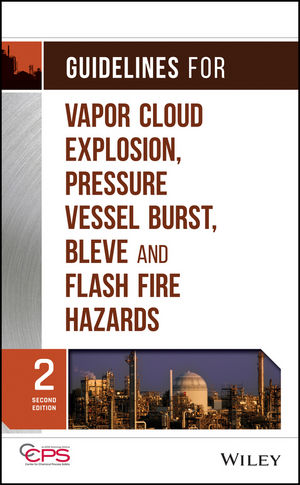Guidelines for Vapor Cloud Explosion, Pressure Vessel Burst, BLEVE, and Flash Fire Hazards, 2nd EditionISBN: 978-0-470-25147-8
Hardcover
456 pages
August 2010
 This is a Print-on-Demand title. It will be printed specifically to fill your order. Please allow an additional 10-15 days delivery time. The book is not returnable.
|
||||||
List of Figures.
Glossary.
Acknowledgements.
1. INTRODUCTION.
2. MANAGEMENT OVERVIEW.
2.1. Flash Fires.
2.2. Vapor Cloud Explosions.
2.3. Pressure Vessel Bursts.
2.4. BLEVEs.
2.5. Prediction methodologies.
3. CASE HISTORIES.
3.1. Historical experience.
3.2. Flash fires.
3.3. Vapor Cloud Explosions.
3.4. Pressure Vessel Burst.
3.5. BLEVE.
4. BASIC CONCEPTS.
4.1. Atmospheric Vapor Cloud Dispersion.
4.2. Ignition.
4.3. Thermal Radiation.
4.4. Explosions — VCE.
4.5. Blast Effects.
5. FLASH FIRES.
5.1. Overview of Experimental Research.
5.2. Flash-Fire Radiation Models.
5.3. Sample Calculations.
6. VAPOR CLOUD EXPLOSIONS.
6.1. Introduction.
6.2. Vapor Cloud Deflagration Theory and Research.
6.3. Vapor Cloud Detonation Theory and Research.
6.4. VCE Prediction Methods.
6.5. Sample problems.
7. PRESSURE VESSEL BURSTS.
7.1. Mechanism of a PVB.
7.2. Scaling Laws Used in PVB Analyses.
7.3. Blast Eeffects of Pressure-Vessel Bursts.
7.4. Methods for Predicting Blast Effects from Vessel Bursts.
7.5. Fragments from a PVB.
7.6. Predicting Fragment Effects from Vessel Bursts.
8. BASIC PRINCIPLES OF BLEVES.
8.1. Introduction.
8.2. Definition of a BLEVE.
8.3. Theory.
8.4. BLEVE Consequences.
8.5. Analytical Models.
8.6. Sample Problems.
9. REFERENCES.
APPENDIX A: VIEW FACTORS FOR SELECTED CONFIGURATIONS.
APPENDIX B: TABULATION OF SOME GAS PROPERTIES IN METRIC UNITS.
APPENDIX C: CONVERSION FACTORS TO SI FOR SELECTED QUANTITIES.



